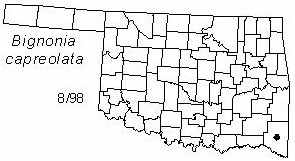
Woody vine climbing by tendrils derived from the terminal leaflet of a trifoliate compound leaf. Leaves pinnately compound, reduced to two basal leaflets and a branched tendril between them. Leaflets glabrous, oblong-lanceolate, acute, 6-15 cm (2.4-6 in) long and 2-7 cm (0.8-2.8 in) wide. Flowers red or orange, funnel-shaped, 5-lobed, 4-5 cm (1.6-2 in) long. Fruits flattened capsules about 15 cm (6 in) long and 2.5 cm (1 in) wide.
Distribution: Gulf Coast north to Maryland and west to Missouri and eastern Texas.
Habitat: Mostly floodplain forests.
NWI status: FAC
Comment: The common name refers to the fact that a cut stem often shows a dark cross-like center. Crossvine is sometimes cultivated for its unusual leaves and large flowers. Bignonia honors Jean Paul Bignon, librarian to King Louis XV of France; capreolata refers to the winding tendrils.
Distribution in Oklahoma: 
BACK
NEXT
RETURN TO INDEX
Last update: 9/8/99
 Go to Oklahoma Biological Survey Home Page
Go to Oklahoma Biological Survey Home Page
 Disclaimer
Disclaimer